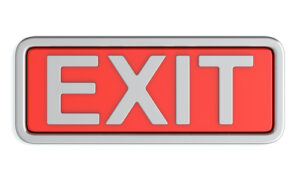
In our last article about life after the sale we discussed identity. Even when business owners are comfortable with who they are, however, there is still the nuts and bolts issue of activity.
A business owner spends 20, 30, or (not uncommonly with Boomers,) 40 years focused on running a business. Unless they’ve built a substantial organization that is run by employees, it likely remains their biggest single time commitment right up until they leave. That commitment is frequently a lot more than 40 hours.
Even if the time “in the office” or “on the job” is less than 40 hours, there are the emails before and after hours, the texts, phone calls from unhappy customers or from employees who aren’t going to make it to work, and just thinking about what comes next, frequently at 2 o’clock in the morning.
Extended Vacation
When asked about activities to fill their week, many owners will say “I’ll have plenty to do!” That isn’t enough. “Plenty” requires some planning if it is really going to occupy the bulk of their work week.
After exiting a business, most owners bask in their newfound freedom. If we presume a selling price that’s substantial enough to allow them a wide range of choices, their first reactions typically include a few lengthy trips. These may range from a long-promised European vacation with the spouse to purchasing an RV to tour the National Parks.
This extended vacation period usually ranges from six months to a year. After that, most owners are looking for something to do. Their grandchildren (and their grandchildren’s parents) are less enthusiastic about having Grandpa and Grandma around too frequently. Travel is too tiring to keep it up indefinitely. Friends are rarely in the same position. Either they are still working and lack the leisure time, or they’ve progressed beyond the extended vacation period and settled down into their own retirement routine.
And as astounding as it may sound to enthusiasts, I’ve heard “I never thought I could play too much golf,” any number of times.
Life After the Sale…and After the Vacation
We use an exercise that brings home just how much the business has dominated an owner’s life. It starts by asking the owner to think a year ahead.
We start with the owner’s “average” work week. Let’s say 50 hours for this example. Then we begin deducting those activities that comprise their impression of “plenty to do,” putting an hourly commitment to each activity.
Regular travel, either for relatives or recreation, still comes close to the top of the list. We ask “How about two weeks away every quarter?” The response is that eight weeks a year is a lot, but could be enjoyable. Then we do the math: 8 weeks x 50 hours= 400 hours of vacation, divided by 52 weeks = 7.7 hours a week. A good start, but we still have 42 hours to fill to replace the business.
How about fitness? Getting into shape is often a goal, but working out every weekday only absorbs another 5 hours.
Working for a cause such as serving lunch at the local homeless shelter a few days a week, can use up another 10-12 hours. We still have 25 hours to go, or about half the time currently spent working.
We can still fit in 18 holes twice a week. That’s 8 more hours. At this point, many owners run out of ideas. That still leaves 17 hours a week, or two full “normal” work days.
The objective isn’t to merely fill up the time slots. It’s to illustrate just how big a void needs to be filled to replace the business. Whether your exit is planned for a year from now or ten, it is time to begin thinking about life after the sale.
John F. Dini develops transition and succession strategies that allow business owners to exit their companies on their own schedule, with the proceeds they seek and complete control over the process. He takes a coaching approach to client engagements, focusing on helping owners of companies with $1M to $250M in revenue achieve both their desired lifestyles and legacies.




 Remote employees can have a dramatic impact on the value of your business. If your exit strategy is to sell to a third party, take some time to think about the areas where offsite workers could have an impact.
Remote employees can have a dramatic impact on the value of your business. If your exit strategy is to sell to a third party, take some time to think about the areas where offsite workers could have an impact. I obviously have my tongue firmly planted in cheek for this column, but my point should be clear. Your business is probably the most valuable asset in your life. Losing it to unplanned events hurts. So even if you are no longer in the picture, you have some responsibility to your family, employees and customers.
I obviously have my tongue firmly planted in cheek for this column, but my point should be clear. Your business is probably the most valuable asset in your life. Losing it to unplanned events hurts. So even if you are no longer in the picture, you have some responsibility to your family, employees and customers.